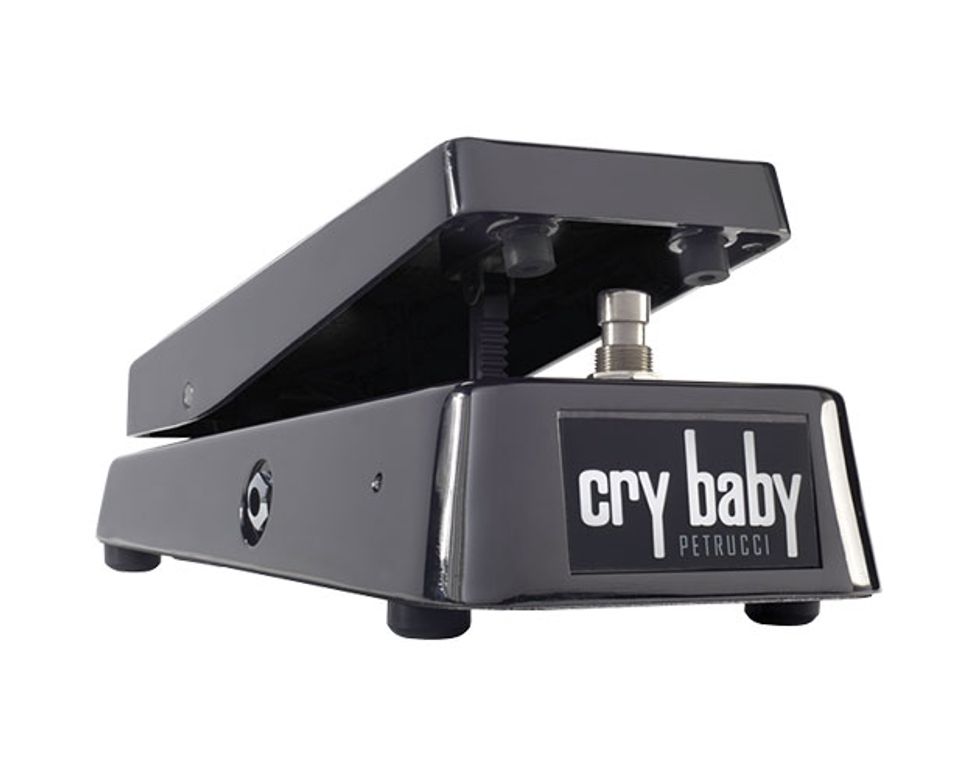The Dunlop John Petrucci JP95 Signature Cry Baby Wah pedal looks flashy and generates tones that effortlessly and authentically nail Petrucci’s identifiable wah sweeps. But there’s much more to this wah than meets the eye, if not the ear. Well-considered trim pots and EQ-shaping tools mean it can be tailored to any high-gain player’s rig.
Looks Mean, Sounds Meaner
The JP95’s sleek, supercar-like aura is arresting, to say the least. It’s finished in very sexy smoked chrome, which makes the pedal a very inviting and easy-to-identify target on a dim stage. The only drawback is that it shows fingerprints and smudging from the realities of stage life very easily. So you might want to keep a polish cloth close by if you’re a neat freak or like to keep your pedal on display.
Two bright blue LED lights adorn both sides to let you know when the effect is engaged. (Why don’t more wah manufacturers do this?) Combined with the chrome, they give the Petrucci a futuristic and somewhat menacing liquid-metal-Terminator-style vibe. Very cool.
Ratings
Pros:
Beautiful supercar-influenced look. Massive, throaty sound that nails Petrucci’s tones. Customizable output, Q, and 6-band EQ. Bright blue LED activation lights.
Cons:
Might sound like a one-trick-pony to vintage wah stylists. One of the more expensive Dunlop wahs.
Tones:
Playability/Ease of Use:
Build/Design:
Value:
Street:
$199
Dunlop JP95 John Petrucci Signature Cry Baby Wah
jimdunlop.com
For all the futuristic exterior features, the JP95 is still a bulletproof Cry Baby at its core. The enclosure is reassuringly weighty, the treadle sweeps smoothly from toe to heel, the switch delivers a perceptible click without being too difficult to engage, and there is no noticeable pop when toggling it on and off.
Devastating Dreams
The JP95’s tone range is based on the settings Petrucci has been using for years on his Dunlop rack wah. And it easily achieves the throaty, aggressive sound that drives Dream Theater songs like “Home.” With my Ibanez RG tuned down to B-standard and running into a high-gain Crate BV300HB head and 4x12 cabinet loaded with Vintage 30 speakers, I realized two things very quickly. First, this is the most gargantuan-sounding wah pedal I’ve ever heard. Second, I can’t even begin to play like John Petrucci. Shortcomings in my Petrucci licks aside, the JP95 put many Dream Theater tones within reach via a wide sweep, rounded highs, sub-like lows, and a substantial volume boost that adds gain, sustain, and cutting presence to your tone.
Basic tones aren’t the only ones available, however. Remove the pedal’s bottom plate and you’ll find an array of trim pots that control the peak volume and Q sweep, and a 6-band equalizer. Though the pedal comes from the factory set for Petrucci’s sound, this feature enables you to tune the wah in very precise, specific ways to suit your rig.
Small tweaks of the trim pots did wonders as I optimized the pedal for various amp and guitar combinations. But no matter what I did with the controls, the JP95 retained its basic fat and throaty essence. That strong personality means some guitar and amp combinations are more ideal pairings than others. A Warmoth T-style guitar into a clean, class-A tube amp was not a perfect match. A PRS CE 24 and cranked plexi-style head, however, were ideal partners.
The Verdict
The Jim Dunlop John Petrucci JP95 Signature Cry Baby Wah is one of the meanest sounding wah pedals in the world. It’s bold, bassy, vocal, and the internal trim pots are powerful tools for fine-tuning your sound. If you’re into heavier styles with liquid, overdriven lead tones, the JP95 wah is definitely worth an audition.




























